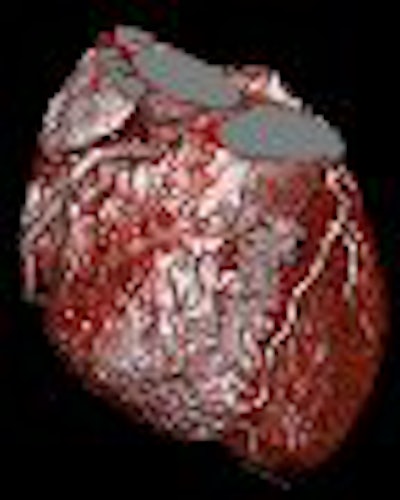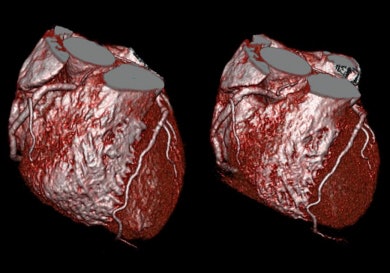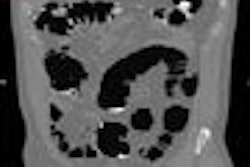
Multimodality vendor Siemens Medical Solutions today launched a new technology that takes a different tack in the never-ending race to produce faster CT scanners. Rather than develop a system with 128 or 256 detector rows, the Malvern, PA, company is launching what it calls dual-source CT -- a new design that uses two sets of x-ray tubes and detector arrays in a single CT gantry.
Siemens launched the scanner, called Somatom Definition, at a news conference Thursday morning in New York City. The product name refers to the technology's ability to produce more definition of detail, resolution, and clinical information than previous CT designs, according to Bernd Ohnesorge, vice president of global CT sales and marketing at the company.
Siemens developed the idea for dual-source CT when trying to figure out the next step in the company's CT program beyond the current generation of 64-slice scanners. The vendor didn't believe that adding more detector rows would be useful in addressing what it felt were the most important segments of advanced CT applications: cardiovascular imaging and acute care, Ohnesorge said.
Working with its group of academic partners, Siemens resurrected the idea of dual-source CT, which had first been introduced years ago on single-slice scanners. The concept involves imaging patients with a CT tube that produces two different x-ray energies, resulting in different tissue absorption characteristics that could be analyzed and processed with techniques like digital subtraction. But dual-source CT on a single-slice scanner never caught on because it requires two separate scans to be performed consecutively.
But what if the scan could be performed with both energies at the same time? Siemens thought it might be possible if two x-ray sources could be placed within the CT gantry, mounted at 90º angles. Opposite the second x-ray source is a second detector array as well.
The configuration is possible because of the compact size of the vendor's z-Sharp tube technology, Ohnesorge said, which uses a flying focal spot to create two x-ray beams simultaneously hitting a 32-row detector, effectively producing 64-slice scans. Like the company's flagship Somatom Sensation system, Somatom Definition uses z-Sharp technology, Ohnesorge said.
The end result is a CT scanner that's twice as fast as even the quickest 64-slice systems on the market, Ohnesorge said. Somatom Definition sports temporal resolution of 83 msec per slice -- and the use of multisector reconstruction algorithms can reduce that to 42 msec per slice. The scanner can conduct a cardiac acquisition in a breath-hold of five to six seconds, versus 10 seconds for a 64-slice system.
"We have achieved with a mechanical CT scanner the temporal resolution of (electron beam CT), but with a spatial resolution of less than 0.4 mm," Ohnesorge said.
While faster is usually deemed better in medical imaging, does the quicker speed have real clinical benefits? Siemens believes it does. For one thing, Somatom Definition users will be able to scan patients with heart conditions, such as arrhythmia, that might have ruled them out for cardiac CT scans in the past. Clinicians will also be able to dispense with the use of beta blockers for slowing heart rates during cardiac CT studies.
 |
| Patient admitted with atypical chest pain under exertion. A six-second cardiac CT scan was performed to rule out coronary artery disease. Heart rate during the scan varied from 79-86 beats per minute. Images demonstrate comparison of the right coronary artery in diastole and systole. The right coronary shows the highest range of motion during the cardiac cycle, and therefore can be difficult to capture. The CT images above are displayed clearly without motion artifacts in both phases. Images courtesy of Siemens Medical Solutions. |
Somatom Definition isn't limited to cardiac scanning, of course. Siemens believes the system's added speed will also show benefits in emergency room and acute care applications. The system can run at 160 kW with a 78-cm gantry diameter, and has a 200-cm scan range.
Finally, the company believes that dual-energy scanning will come into its own with the new system. The technique should improve CT's performance in tissue characterization and in differentiating vasculature versus bone and soft tissue.
But what about radiation dose? With two x-ray tubes firing away at once, won't patients also be getting double the radiation? The answer is no, Ohnesorge said. Somatom Definition cuts in half the amount of dose delivered in cardiac applications because its high temporal resolution limits the amount of time during the cardiac cycle when maximum power is applied.
Siemens will also include processing software with the system to help users cope with the extra data it produces. The company's syngo image processing tools, such as syngo InSpace for 3D review and syngo Circulation for cardiac studies, can handle thousands of slices, Ohnesorge said.
The first Somatom Definition scanner is running at the University of Erlangen in Germany, with the first U.S. installation scheduled for January 2006. A clinical evaluation phase will follow in which the system will be installed at 10 beta sites around the world, with commercial shipments beginning in the summer of 2006.
The scanner will carry a list price of $2.7 million to $3.2 million depending on configuration, compared with $1.4 million to $1.7 million for the company's flagship Somatom Sensation system. The scanner has FDA clearance.
In addition to being discussed in Siemens' booth at this month's RSNA meeting, the technology will also be the subject of scientific presentations SSJ18-06 , SSM08-06 , SSM17-05, and LPH12-04.
By Brian Casey
AuntMinnie.com staff writer
November 17, 2005
Related Reading
Siemens debuts syngo Beat at AHA, November 14, 2005
Road to RSNA, Siemens Medical Solutions, November 11, 2005
Road to RSNA, Siemens Medical Solutions, November 10, 2005
Road to RSNA, Siemens Medical Solutions, November 9, 2005
Road to RSNA, Siemens Medical Solutions, November 8, 2005
Copyright © 2005 AuntMinnie.com




















